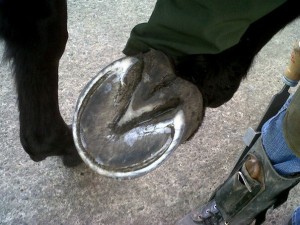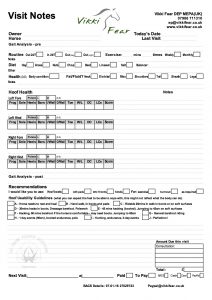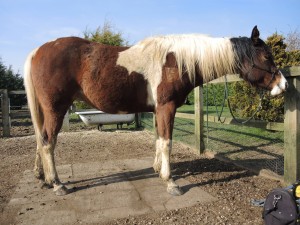The Consultation Process
Appointments are generally available Monday, Wednesday, Friday 9.30am to 4.30pm (3.30pm in winter unless you have good lighting). I can sometimes make exceptions to these times in extenuating circumstances. A standard consultation takes about one hour, sometimes a little less with uncomplicated cases. Expect the first visit to take up to two hours, though often this is nearer 90 minutes. I will aim to arrive at the agreed time for an appointment, if I am expecting to be more than 15minutes late (due to traffic issues for example), I will endeavour to let you know my new ETA.
At each visit I will be interested in what you have been up to with your horse, any changes to routine, paddock or bucket feed, increases or decreases in exercise amount or intensity, new tack, new training methods, etc. Apart from it being nice to know what my clients get up to, all of this and more can affect the feet so it is useful to know. I would also like to know about illnesses, lamenesses, worming, inoculations etc.
I will thoroughly pick out all the hooves (having them clean and dry to start with is always a bonus) and examine the “balance” of the hoof – look at the length and width proportions, the height of wall above sole at toe, quarters and heels, examine the size and health of the frog and assess the quality of all the structures.,/p>
I will assess your horse at walk on a hard level surface if one is available and may ask you to trot, depending on the quality of the hooves and what I see at walk.
I will regularly photograph the hooves, either before or after a trim, to monitor progress and especially if something interesting is happening to the hoof.
Trimming

Image courtesy of Claire Spelling
I may trim all or part of each foot. The actual trim may be a very small part of my visit, if the horse is maintaining balance well and is sound, then we may extend the duration between trims, if I need to take large amounts of hoof at each visit, I will recommend a shorter interval.
I don’t follow a “method” for trimming, but use certain landmarks to guide me and will trim each hoof on each horse as I believe is required for that horse on that day, just because I did something last time or on another foot doesn’t mean it needs doing this time or on this foot.
Records

Once I have trimmed the hooves, I may photograph the feet. I may apply some topical remedies to aid recovery from wall or frog damage and I may watch your horse move again, especially if we made large corrections or there were anomalies prior to the trim. I will then write up a set of notes and give scores to various elements of the hooves that indicate quality and strength of the structures and guide usability of the feet. I will send you a copy of my notes and recommendations for changes or tweaks via email, along with my invoice after the visit.
Next Appointment
I have found over the years that hooves improve the most with frequent small adjustments, so they don’t get the opportunity to get out of shape between visits, therefore my recommendation is for all horses to be on a 4-5 week schedule. I prefer to schedule the next appointment while we are together, so that the hooves don’t get a chance to get out of shape between trims and will note this on the form before handing it to you. This appointment can usually be changed if something comes up or you feel you need to see me sooner – the more notice you can give the more flexible I can be.
I will message you the night before the scheduled appointment to confirm the visit time. I believe in flexibility, so am usually OK if an appointment needs to be rescheduled due to extenuating circumstances, but would prefer as much notice as you can give me in that situation. Likewise, on the rare occasion that I need to change an appointment, I will endeavour to provide you with plenty of notice, and will try to be as flexible in rearranging the visit as I can.
What do I need from you?

In return for the above, I ask:
- That you or a responsible representative (no unattended under 16s) attends each and every visit.
- The horse be caught, and waiting in an area where they are used to having their feet done on a regular basis. This should be safe, level and free from trip and kick hazards.
- The horse be dry, cleanish and waiting for me with clean, dry legs and hooves. If the legs are wet and muddy, please use an old towel to clean them rather than water, especially in winter.
- The horse has been taught to stand on three legs and is able to have the fourth up for long enough that I can at least pick-out any remaining debris, tidy the frog and assess the balance of the foot. If you are not sure if your horse is at this stage of his/her training, we can arrange for you to send me a short video, showing where you are at. If further training is required we can work on that as a separate issue.
- I ask that you keep the horse occupied at the front end while I am bent over so they don’t feel compelled to investigate my back. Whilst this looks cute, it can very quickly turn into something nasty, if the horse decides to bite (I know, your horse doesn’t bite), or suddenly spooks while they are leaning on me.
- Trimming is hard work, I get very thirsty, especially if I have several horses to trim in quick succession so if you have the facilities, a cup of tea would be very much appreciated, a biscuit or piece of cake to keep my energy up would also go down a treat {cheeky wink}.
I understand that some of my requirements are hard to come by at certain times of the year, with the good old british weather, but appreciate any effort you can put in to remove wet slimy mud from rugs, hooves and legs (use an old towel or hay/straw rather than water). Any shelter or dry standing that can be found makes everyone’s day more pleasant (if you don’t have any hard standing at your yard, old carpet pieces can be really helpful to tame the mud) . If the weather is going to be really foul, and you have no shelter available, it may be easier for all concerned to reschedule on occasion.
